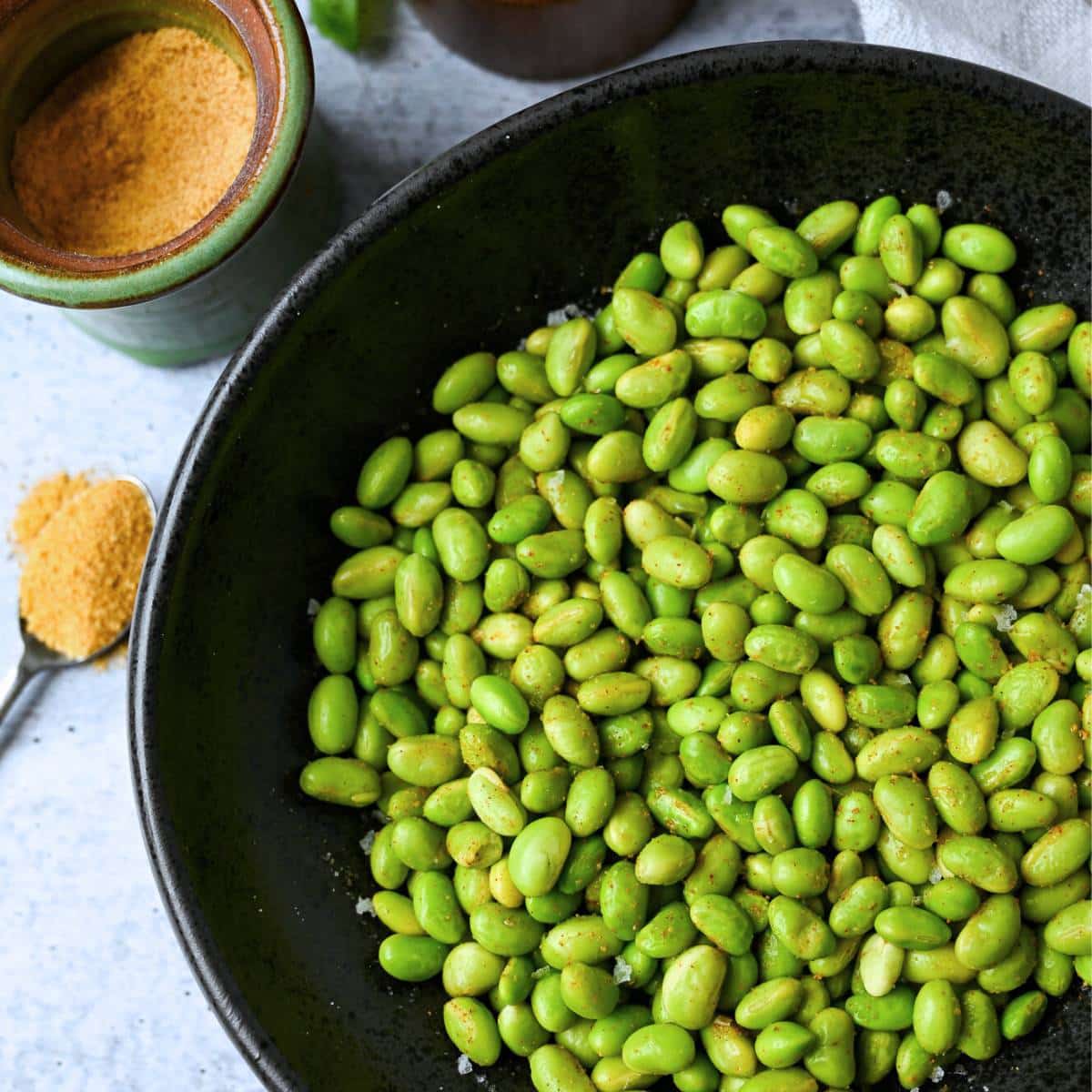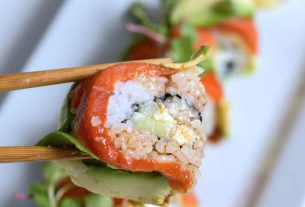Did you know that there’s more to soybeans than meets the eye?
Meet edamame and its lesser-known sibling, mukimame.
These tiny legumes pack a punch of flavour and are not only incredibly nutritious but also incredibly versatile.
Whether you prefer the pod or the shelled variety, edamame and mukimame are here to revolutionize your culinary adventures.
mukimame
Edamame and mukimame are both types of soybeans, but the main difference is that edamame refers to young, green soybeans still in their pods, while mukimame refers to shelled edamame.
Edamame is typically consumed as a snack or side dish, while mukimame can be easily incorporated into various dishes.
They both offer similar nutritional benefits, including being a good source of plant-based protein, fiber, and vitamins.
Key Points:
- Edamame and mukimame are types of soybeans with the main difference being that edamame is young, green soybeans in pods, while mukimame is shelled edamame.
- Edamame is commonly eaten as a snack or side dish, while mukimame can be used in various dishes.
- Both edamame and mukimame provide similar nutritional benefits.
- They are both rich in plant-based protein, fiber, and vitamins.
- Edamame is consumed in its whole form, while mukimame is consumed after the pods have been removed.
- Mukimame is a convenient option for adding soybean nutrition to meals and recipes.
mukimame – Watch Video
💡
Pro Tips:
1. Mukimame, also known as edamame, are young soybeans that are harvested and consumed before they mature.
2. The word “mukimame” is derived from the Japanese words “muki,” meaning “peeled,” and “mame,” meaning “bean.”
3. Mukimame is considered a complete protein, as it contains all nine essential amino acids required by the human body.
4. In Japan, mukimame is often served as a snack or appetizer, and is commonly enjoyed by popping the beans out of their pods directly into the mouth.
5. Mukimame is a versatile ingredient and can be used in a variety of dishes, including soups, stir-fries, salads, and even as a topping for pizzas.
1. Edamame Vs. Mukimame: What’s the Difference?
Edamame and mukimame are two different types of soybeans that have varying methods of preparation and presentation.
Edamame refers to young green soybeans that are harvested before they fully mature and harden. These soybeans are still enclosed in their vibrant green pods and are commonly enjoyed as a popular snack or incorporated into various recipes.
Mukimame, on the other hand, refers to shelled edamame beans. The pods are removed, resulting in soft and tender soybeans. This shelling process allows mukimame to be directly used in recipes without requiring any additional preparation.
The primary difference between edamame and mukimame lies in their physical form. Edamame is typically eaten with the pod, while mukimame consists of the shelled soybeans. This distinction impacts their taste, texture, and cooking methods.
2. Taste and Texture Comparison: Edamame Vs. Mukimame
Despite their similarities, edamame and mukimame have slight differences in taste and texture.
- Edamame:
- Taste: Possesses a mild, slightly sweet, and nutty flavor.
-
Texture: The beans inside the pods are tender, while the pods themselves are fibrous and not meant to be eaten.
-
Mukimame:
- Taste: Offers a more concentrated, nutty, and buttery flavor, slightly stronger than edamame.
- Texture: The shell-less beans are firmer, providing a more satisfying and substantial texture to dishes. They hold their shape well, making them suitable for boiling, steaming, or stir-frying.
Both edamame and mukimame can be enjoyed in various culinary preparations, offering different taste profiles and textures.
3. Cooking and Preparation Methods for Edamame and Mukimame
Edamame and mukimame are both types of soybeans that can be prepared using various cooking methods. However, their different presentations require distinct approaches:
-
Edamame, with its pods intact, is typically boiled or steamed with salt. The pods are then served whole, and the individual beans are squeezed out of the pod when eaten. This interactive process adds to the enjoyment of eating edamame as a snack.
-
Mukimame, on the other hand, provides greater versatility in cooking. With the beans already shelled, they can be incorporated directly into dishes without the need to remove them from the pod first. They can be boiled, steamed, or stir-fried, depending on the desired texture and flavor.
-
Some key differences between edamame and mukimame:
- Edamame is eaten with the pods, while mukimame has the pods removed.
- Edamame is typically boiled or steamed, while mukimame can be boiled, steamed, or stir-fried.
- The interactive process of squeezing out the beans from the pod adds to the enjoyment of eating edamame.
- Mukimame offers greater convenience in cooking as the beans are already shelled.
In conclusion, both edamame and mukimame are delicious and nutritious soybean options, but they require different preparation methods due to their distinct presentations.
4. Nutritional Comparison: Edamame Vs. Mukimame
Both edamame and mukimame are powerhouses of nutrition, offering notable health benefits. They are excellent sources of plant-based protein, dietary fiber, vitamins, and minerals. These legumes are low in saturated fat and cholesterol, making them a healthy choice for those seeking a balanced diet.
In terms of nutrition, a half-cup serving of mukimame contains approximately 10 grams of protein, 5 grams of fiber, 5 grams of fat, and 120 calories. Edamame, considering the weight of the pods, may have a slightly higher caloric content. However, both varieties provide similar amounts of protein and fiber.
The vitamin and mineral content of edamame and mukimame are also noteworthy. They are rich in nutrients such as Vitamin K, iron, magnesium, and calcium. These legumes can contribute to overall health and well-being and are particularly beneficial for individuals following plant-based or vegetarian diets.
5. Serving Suggestions for Mukimame and Edamame
Mukimame and edamame are both versatile and healthy additions to meals. Here are some serving suggestions:
-
Mukimame: This shelled form of soybeans is perfect for Asian-inspired dishes, stir-fries, rice bowls, and salads. Its nutty and buttery flavor complements a variety of ingredients. You can also add mukimame to soups and stews in place of other beans.
-
Edamame: Traditionally enjoyed as a snack or side dish in East Asian cuisines, edamame can be boiled or steamed and sprinkled with salt. The whole pods can be served as a finger food, providing a fun and interactive experience of squeezing the beans out when eating. For additional texture and nutrition, try adding edamame to salads, pasta dishes, and vegetable stir-fries.
Remember to experiment and get creative with these beans to discover your favorite culinary combinations!
- For Mukimame:
- Asian-inspired dishes
- Stir-fries
- Rice bowls
- Salads
-
Soups and stews
-
For Edamame:
- Boiled or steamed with salt as a snack or side dish
- Finger food by eating the pods
- Salads
- Pasta dishes
- Vegetable stir-fries
Don’t be afraid to mix and match these versatile beans to elevate your recipes!
6. Storage Instructions for Cooked Edamame and Mukimame
If you have cooked and cooled mukimame or edamame, it can be refrigerated in an airtight container for 2-3 days. To prolong shelf life, freezing is a convenient option. Both edamame and mukimame can be frozen for 2-3 months without significantly affecting their taste and texture.
To freeze, it is recommended to blanch the beans briefly in boiling water, followed by an ice bath to stop the cooking process. Once blanched and cooled, transfer the beans to a freezer-safe container or airtight bag, removing as much air as possible. Properly stored edamame and mukimame will maintain their quality for several months, allowing you to enjoy their nutritional benefits at any time.
7. FAQs: Are Edamame and Mukimame Gluten-Free and Keto-Friendly?
Edamame and mukimame are naturally gluten-free, making them suitable for individuals with gluten sensitivities or Celiac disease. These soybeans do not contain any wheat, barley, or rye, which are primary sources of gluten. They can be incorporated into gluten-free diets and recipes without concern.
In terms of their compatibility with keto diets, edamame and mukimame can be included in moderation as part of a well-balanced ketogenic meal plan. While they contain carbohydrates, these legumes are low in net carbs when considering the fiber content. As always, it is crucial to pay attention to portion sizes and consider the overall macronutrient composition when incorporating edamame or mukimame into a keto lifestyle.
8. Seasoning Variations for Mukimame
Mukimame offers a versatile base for experimenting with various seasoning options, allowing you to tailor the flavor to your liking. While plain mukimame is delicious on its own, adding seasonings can take it to a whole new level.
Garlic parmesan is a popular choice that combines the flavors of garlic and cheese, giving the beans a delightful and savory taste. If you prefer a bit of heat, spicy chili lime seasoning provides a zesty and fiery kick. On the other hand, if you crave a touch of sweetness, teriyaki seasoning can create a pleasurable umami experience. These examples are just a starting point, and you can get creative by experimenting with various herbs, spices, and flavor combinations to craft your own unique seasoned mukimame.
9. Availability of Edamame Vs. Mukimame in Stores
Edamame, a popular snack and appetizer, is widely available in grocery stores and Asian markets. Fresh edamame pods can be found in stores during late summer and early fall when in season. These can be purchased for home cooking or enjoyed at restaurants offering edamame.
Mukimame, also known as shelled edamame, can typically be found in the frozen section of grocery stores. The shelling process involved in producing mukimame makes it more convenient for consumers. Frozen mukimame is readily available in many countries, allowing you to enjoy the convenience and health benefits of these shelled soybeans year-round.
- Edamame is a popular snack and appetizer.
- Fresh edamame pods are available during late summer and early fall.
- Edamame can be purchased for home cooking or enjoyed at restaurants.
- Mukimame, or shelled edamame, can be found in the frozen section of grocery stores.
- The shelling process makes mukimame more convenient for consumers.
- Frozen mukimame is available year-round.
- Enjoy the convenience and health benefits of these shelled soybeans.
10. The Cultural Significance of Edamame and Mukimame
Edamame and Mukimame: A Brief Culinary Journey
Edamame and mukimame hold significant cultural importance in East Asian cuisines. Let’s explore their rich history and shed light on their culinary versatility.
-
In Japan, edamame has served as a traditional snack and side dish for centuries, gaining popularity during the Edo period. It represents the transition from summer to autumn and the impending harvest.
-
Similarly, in China, edamame is considered one of the “Five Sacred Grains” and holds cultural significance. This legume, along with other soybeans, plays a vital role in Chinese cuisine. It is enjoyed as a delightful snack or a complementary side dish. Moreover, regional cuisines utilize the entire soybean plant to create special soups.
The timeless appeal of these legumes has transcended borders, reaching kitchens worldwide. As the focus on health and plant-based diets intensifies, edamame and mukimame have emerged as versatile and nutritious ingredients, loved by many. Incorporating these soybeans into your cooking offers a myriad of benefits, including:
-
Health Boost: Edamame and mukimame pack a powerful nutritional punch, containing essential vitamins, minerals, and antioxidants. They are excellent sources of protein, fiber, and healthy fats, promoting overall well-being.
-
Versatile Additions: Whether you prefer the interactive aspect of edamame or the convenience of mukimame, these legumes enhance a wide variety of dishes. From salads to stir-fries and soups, their unique texture and flavor elevate culinary creations.
-
Culinary Delights: Edamame and mukimame bring a delightful touch to any recipe. Their tender, sweet taste provides a pleasant contrast in both traditional and modern dishes, making them a top choice for chefs and home cooks alike.
Embrace the culinary adventure offered by edamame and mukimame. Unlock the plethora of health benefits they possess and take your cooking to new heights. Remember, whether you enjoy the traditional charm of edamame or the convenience of mukimame, these soybeans are bound to impress.
Let your creativity flourish as you explore the endless possibilities these legumes provide.
-
Takeaways:
-
Edamame and mukimame have a rich history and cultural significance in East Asian cuisines.
- Japan associates edamame with the end of summer, symbolizing changing seasons and the harvest.
- In China, edamame is one of the “Five Sacred Grains” and widely used in regional cuisines.
- Edamame and mukimame have gained global popularity due to their health benefits and culinary versatility.
- Incorporating these legumes into your diet adds taste, nutrition, and creativity to your cooking.
💡
You may need to know these questions about mukimame
What does Mukimame mean?
Mukimame is a term used to describe soybeans that have been shelled before cooking. Derived from the legume family, mukimame and edamame are both immature soybeans with a slight variation in preparation. Unlike edamame, which involves cooking the soybeans in their pods, mukimame refers to the shelled soybeans ready for cooking.
What’s the difference between edamame and Mukimame?
While edamame and mukimame both hail from the same family of young soybeans, their main distinction lies in their preparation. Edamame are typically enjoyed in their pods, cooked and seasoned as a delightful snack. On the other hand, mukimame are the shelled form of these soybeans, granting them the convenience of being directly incorporated into various dishes, such as vibrant salads or flavorful stir-fries.
Why can’t you eat a lot of edamame?
Consuming excessive amounts of edamame can lead to digestive issues. This is especially true when it is eaten raw or undercooked. Some potential risks of edamame include bloating, gas, and cramping. Individuals with irritable bowel syndrome may be more susceptible to experiencing gastric upset and pain after consuming edamame. Therefore, it is important to moderate the intake of edamame to avoid these potential digestive problems.
What is the benefit of edamame?
The benefit of edamame lies in its unique nutritional profile. Being low in carbohydrates, edamame is a great option for those looking to manage their blood sugar levels. Additionally, it is a rich source of protein, fat, and fiber, making it a satiating and nutritious addition to meals or snacks. What sets edamame apart is its remarkably low ranking on the glycemic index, indicating that it has a minimal impact on blood sugar spikes when consumed.
Reference source
https://ameessavorydish.com/spiced-mukimame-healthy-snacking/
https://bayevskitchen.com/mukimame-vs-edamame/
https://www.medicinenet.com/is_edamame_good_or_bad_for_you/article.htm
https://www.eatingwell.com/article/8049006/health-benefits-of-edamame/



